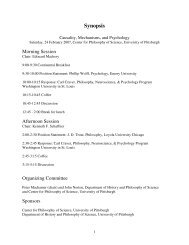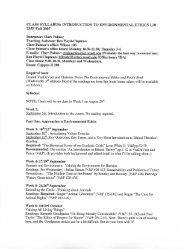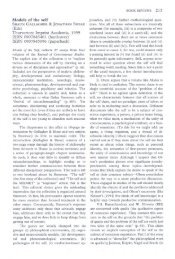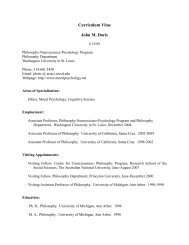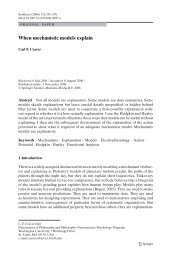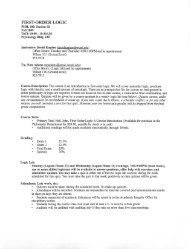The Blackwell Guide to the Philosophy of Science - The Department ...
The Blackwell Guide to the Philosophy of Science - The Department ...
The Blackwell Guide to the Philosophy of Science - The Department ...
You also want an ePaper? Increase the reach of your titles
YUMPU automatically turns print PDFs into web optimized ePapers that Google loves.
Classic Debates, Standard Problems, Future Prospects<br />
probability that Einstein’s <strong>the</strong>ory is true, given <strong>the</strong> evidence is, say, 0.8 means that<br />
<strong>the</strong> evidence entails Einstein’s <strong>the</strong>ory <strong>to</strong> degree 0.8. (Here full – deductive –<br />
entailment would <strong>of</strong> course be degree 1, that is, <strong>the</strong> probability <strong>of</strong> A given B is 1<br />
whenever B deductively entails A.) This idea might <strong>the</strong>n be used <strong>to</strong> supply <strong>the</strong><br />
rationale for scientific revolutions if it could be shown that <strong>the</strong> newer <strong>the</strong>ory – say<br />
Einstein’s <strong>the</strong>ory – has higher probability in <strong>the</strong> light <strong>of</strong> <strong>the</strong> evidence available at<br />
<strong>the</strong> time <strong>of</strong> <strong>the</strong> “revolution” than had <strong>the</strong> earlier <strong>the</strong>ory – in this case New<strong>to</strong>n’s.<br />
Intuitively, although <strong>the</strong> evidence <strong>of</strong> course entails nei<strong>the</strong>r <strong>the</strong>ory, it comes closer<br />
<strong>to</strong> entailing Einstein’s <strong>the</strong>ory than <strong>to</strong> entailing New<strong>to</strong>n’s.<br />
This idea, for all its simplicity and appeal, fails. <strong>The</strong> basic problem is essentially<br />
<strong>the</strong> same as <strong>the</strong> one that afflicts <strong>the</strong> so-called classical account <strong>of</strong> probability –<br />
which defines <strong>the</strong> probability <strong>of</strong> some event A as <strong>the</strong> ratio <strong>of</strong> <strong>the</strong> number <strong>of</strong><br />
“equally possible” cases in which A holds <strong>to</strong> <strong>the</strong> number <strong>of</strong> all <strong>the</strong> equally possible<br />
cases. (Intuitively <strong>the</strong> probability that a fair dice when rolled will finish with<br />
“6” up is 1 /6 because <strong>the</strong>re are six equally possible cases and just one in which<br />
<strong>the</strong> event “6 up” occurs; <strong>the</strong> probability that an even numbered face will be uppermost<br />
in <strong>the</strong> same situation is 3 /6, i.e. 1 /2 since <strong>the</strong>re are again six equally possible<br />
outcomes and in three <strong>of</strong> <strong>the</strong>m <strong>the</strong> event “even number uppermost” is instantiated.)<br />
<strong>The</strong> difficulty concerns <strong>the</strong> notion <strong>of</strong> partitioning <strong>the</strong> set <strong>of</strong> all <strong>the</strong> possible<br />
events in some experiment in<strong>to</strong> <strong>the</strong> “equally possible” ones. In general, <strong>the</strong>re are<br />
different ways <strong>of</strong> doing this and it seems impossible <strong>to</strong> argue that only one such<br />
way is “correct.” And yet with a different partition <strong>of</strong> <strong>the</strong> events in<strong>to</strong> equally<br />
possible cases we arrive at different probabilities.<br />
Although this approach and this difficulty for it were originally developed in<br />
<strong>the</strong> context <strong>of</strong> probabilities <strong>of</strong> various events, an entirely analogous approach, and<br />
an entirely analogous difficulty, can be developed when thinking, as Carnap did,<br />
<strong>of</strong> <strong>the</strong> probability that a particular sentence is true. Suppose, for example, we are<br />
interested in hypo<strong>the</strong>ses about <strong>the</strong> contents <strong>of</strong> an urn known <strong>to</strong> contain, say, 50<br />
balls, each <strong>of</strong> which is ei<strong>the</strong>r black or white but in an unknown proportion; suppose<br />
fur<strong>the</strong>r that we are (for some reason) unable <strong>to</strong> break open <strong>the</strong> urn and our evidence<br />
is restricted <strong>to</strong> drawing some number <strong>of</strong> balls from <strong>the</strong> urn, with replacement,<br />
and noting <strong>the</strong>ir colours. What constitute <strong>the</strong> equally likely cases here? All<br />
possible proportions <strong>of</strong> black <strong>to</strong> white balls – all 50 black, 49 black 1 white, 48<br />
black 2 white, etc.? Or are <strong>the</strong> equally likely cases specified by assuming that each<br />
individual ball has <strong>the</strong> same chance <strong>of</strong> being white as <strong>of</strong> being black? It seems<br />
difficult indeed <strong>to</strong> argue that one <strong>of</strong> <strong>the</strong>se notions is <strong>the</strong> “correct” one. But it is<br />
no surprise that <strong>the</strong> two yield quite different probabilities for various hypo<strong>the</strong>ses.<br />
Suppose we are interested in <strong>the</strong> hypo<strong>the</strong>sis that exactly half <strong>of</strong> <strong>the</strong> balls are white<br />
and our evidence is that we have drawn 10 balls, 6 <strong>of</strong> which are white. <strong>The</strong> inductive<br />
support given <strong>to</strong> that hypo<strong>the</strong>sis by that evidence, <strong>the</strong> degree <strong>to</strong> which <strong>the</strong><br />
evidence partially entails <strong>the</strong> hypo<strong>the</strong>sis, will be quite different depending on which<br />
<strong>of</strong> <strong>the</strong>se two ways we slice up <strong>the</strong> “equal possibilities”; and this makes it very<br />
difficult <strong>to</strong> claim that <strong>the</strong>re is one objective probability for <strong>the</strong> hypo<strong>the</strong>sis in <strong>the</strong><br />
light <strong>of</strong> <strong>the</strong> evidence.<br />
23



